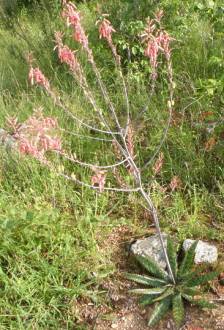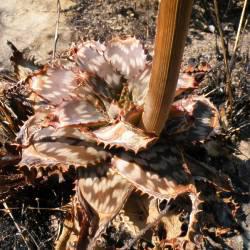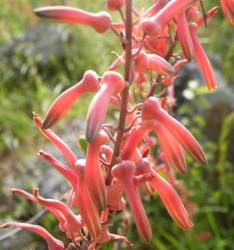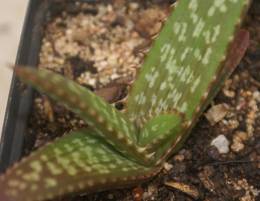Aloe zebrina
Aloe zebrina Baker
Family: Asphodelaceae
Common names: zebra leaf aloe, spotted aloe (Eng.)
Introduction
Imagine creating a breathtaking desertscape of rocks and pebbles and incorporating patches of Aloe zebrina in your illusion. This aloe is a sure must in your rockery.

Description
Description
Aloe zebrina is a small, variable, compact succulent. Succulents are plants that are able to store water in their stems, leaves or roots, and so enabling the plant to survive in arid conditions and in times of drought or water deficiency.

The succulent leaves of Aloe zebrina are densely clustered into a rosette and have a slightly channelled upper surface. The leaves vary greatly in colour but they are usually green and marked with large oblong whitish spots; the margins are armed with stout, brown-tipped teeth and the leaf tips are dark red to brown.

It has pale but striking red tubular flowers that occur in rather sparse inflorescences. The fruit is a dehiscing capsule with many seeds. Seeds are dark-coloured and broadly winged, which assists in dispersal.
Conservation Status
Status
Aloe zebrina is not listed as threatened, mainly due to its wide distribution.
Distribution and habitat
Distribution description
Aloe zebrina is widespread in northern South Africa and is also widely distributed in Namibia, Zambia, Angola, Mozambique and Zimbabwe.
Derivation of name and historical aspects
History
The specific epithet means striped like a zebra and refers to the markings of the leaves. The genus Aloe comprises of about 400 species, of which 275 species are found in mainland Africa, 15 in Arabia and 40 in Madagascar.
Ecology
Ecology
The habitat of Aloe zebrina is normally dry thickets and may include marshy meadows on river banks. It suckers freely and therefore forms dense groups. Blooms are mainly found from February to May, but also June to August. The pollination is performed by birds (ornithophily).
Uses
Use
In north-western Botswana the roots of Aloe zebrina are among the main dyes for the Hyphaene palm fibres, which are used in weaving baskets, to give them a golden-yellow colour. The method was adopted for wool dyeing by European settlers who modified it to create better colours with other metallic mordants. The roots can easily be collected on a sustainable basis because of the plant's ability to readily form new roots.
The people along the Kunene River in Angola prepare cakes from the pressed and boiled flowers. The powdered stem and leaf bases are taken medicinally by women after delivery to cleanse their system. The (bitter) juice of many Aloe species is used as a disinfectant for wounds, to expel worms and also to treat skin problems.
Aloe zebrina has potential for cultivation in arid to semi-arid, frost-free locations.
Growing Aloe zebrina
Grow
Aloe zebrina can be grown from either seed or stem cuttings. Seed should not be sown too deep and can be covered with a layer of coarse sand. Light watering is required, with sufficient drainage. Do not overcrowd the seed. Stem cuttings can easily be made from the parent plant and left to dry. A powder fungicide may be used to prevent damping off and other diseases. When the cuttings are dry, they can be inserted into a sandy medium.
This aloe, like any other plant, should be treated according to its natural conditions. This is not a fussy plant and can easily be maintained in the garden.

References
- Jansen, P.C.M., 2005. Aloe zebrina Baker. Record from Protabase. Jansen, P.C.M. & Cardon, D. (Editors). PROTA (Plant Resources of Tropical Africa / Ressources végétales de l'Afrique tropicale), Wageningen, Netherlands. http://database.prota.org/search.htm
- Oliver, I.B.. 1998. Grow succulents. Kirstenbosch Gardening Series. National Botanical Institute, Cape Town.
- Smith, G. 2005. Gardening with succulents.
- Van Wyk, B.-E. & Smith, G. 2003. Guide to the aloes of South Africa, edn 2. Briza Publications, Pretoria.
Credits
Hildegard Witbooi
Kirstenbosch National Botanical Garden
January2011
Plant Attributes:
Plant Type: Succulent
SA Distribution: Gauteng, Limpopo, Mpumalanga, North West
Soil type:
Flowering season: Late Summer, Autumn
PH:
Flower colour: Red, Pink
Aspect:
Gardening skill: Easy
Special Features:
Horticultural zones









Rate this article
Article well written and informative
Rate this plant
Is this an interesting plant?
Login to add your Comment
Back to topNot registered yet? Click here to register.